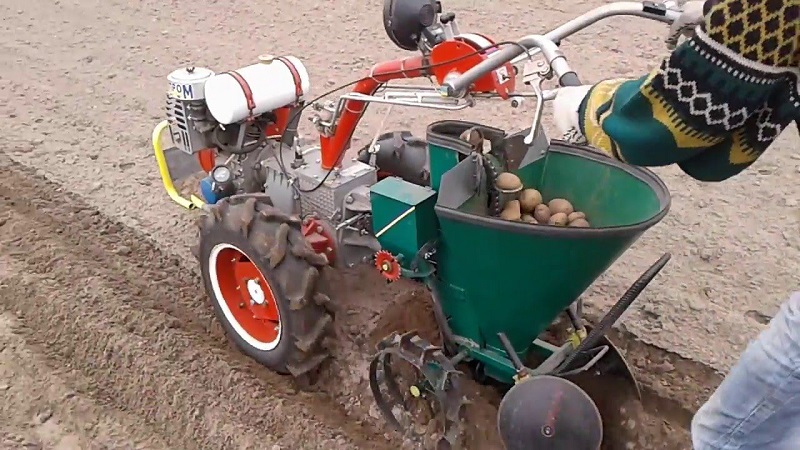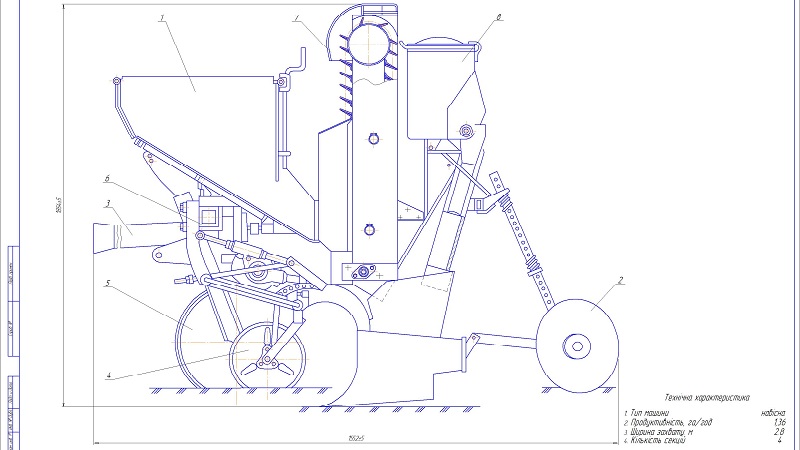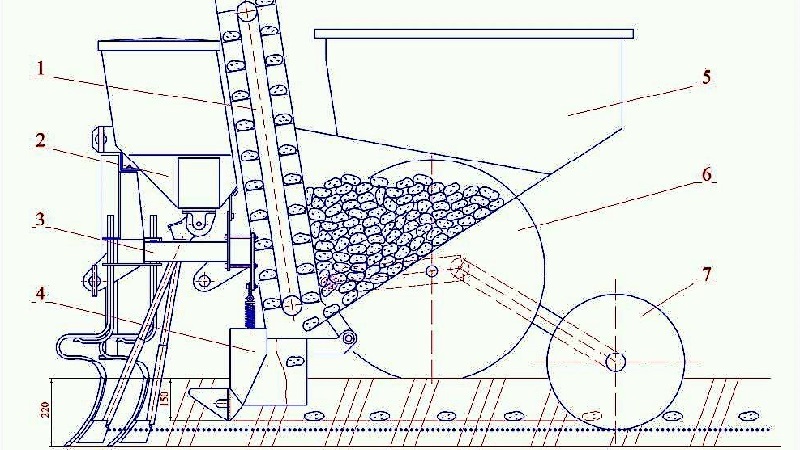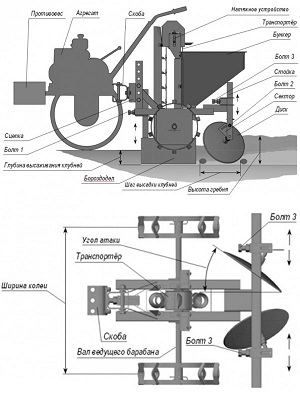Review of potato planters for a walk-behind tractor and how to make it yourself
A potato planter is an agricultural unit that can significantly increase labor productivity when planting potatoes. The process requires less effort and time than manual planting. As a means of small-scale mechanization of labor, a potato planter for a walk-behind tractor is focused exclusively on summer residents and other small agricultural producers. For these users, the cost of the unit is of paramount importance. We will tell you in detail how to save money by assembling the device with your own hands.
The content of the article
What is a potato planter
The potato planter automatically plants the tubers at regular intervals and covers them with soil.
Important! The unit is equipped with a power plant that ensures its movement along the bed and creates sufficient traction for continuous dusting of the tubers with soil. That is, it is quite possible to convert an ordinary walk-behind tractor for a potato planter.
Technologically, the potato planter can be divided into three components:
- Power block.
- Bunker for storing and feeding potatoes for planting.
- Openers for raking the soil (for covering tubers placed in the beds).

Depending on the engine power of the walk-behind tractor potato planters differ in the following functional characteristics:
- By the speed of passage and planting of tubers.
- By the volume of the bunker in which the seed is placed (the more powerful, the more potatoes).
- By the provided embarkation depth. The performance of the openers depends on the power of the power unit, or rather, with what type of land they can work. The more powerful the engine, the more soil the block can cover the planted tubers.
Planting depth is not a determining factor, because in the process of processing potatoes, it will still have to be hilled.
Important! Planting too deep will result in longer germination of the seedlings, which will shorten the overall length of the growing season.
Any potato planter needs a competent operator. It is not just a person who directs the block in the right direction. He must understand the whole process of planting potatoes and carefully follow the sequence of actions:
- First, the site must be loosened (plowed), if it is virgin land, or it is enough to simply plow it if the land is cultivated every year.
- Furrows must then be cut at least 40 cm high.
- Further, fertilizers should be placed in the grooves of the furrows - rotted manure or a mixture of nitrogen-potassium-phosphorus fertilizers.
And only then do they start landing. If you do the work by hand, it will take at least five times longer than mechanizing the process. And, of course, ten times more effort. therefore of the main advantages of using a potato planter can be distinguished:
- multiple increase in productivity;
- minimization of steps for tillage;
- the same embarkation depth;
- ensuring a standard distance between tubers;
- relative ease of use.
Types of potato planters
Potato planters for walk-behind tractor differ in the following characteristics.
By the number of rows processed
Allocate units for one and two rows... Naturally, a two-row planter should have a more powerful engine: if an engine of 6 liters or more is enough for a single-row planter. from. (as, for example, the Neva walk-behind tractor has 6.5 liters. from.), then the two-row unit must have a capacity of at least 9 liters. from. (as, for example, in the Belarus-09N walk-behind tractor). A two-row block, of course, is potentially more productive, but its processing speed is about 1.5 times slower than that of a single-row one. In addition, it requires higher operator qualifications.

Depending on the manufacturer
These devices are produced by many Russian and Belarusian machine-building enterprises., even not necessarily profile ones (for example, within the framework of conversion). Noteworthy are the domestic models KS-1, KS-1A, KSM-1, KTS-2 and KTS-4 for one, two or four rows, respectively.
Reference. The pattern is simple: domestic and Belarusian equipment is several times cheaper than imported.
By type of technological process
In low-capacity potato planters, the planting of potatoes is divided into two stages:
- first, the tubers are laid out in the furrows;
- in the second pass, the machine covers the furrow with soil.
For potato planters with stronger engines, this process can be combined: the machine immediately spreads the tubers and covers them with earth in one pass.
Interesting on the site:
Review and comparison of the best potato planters for walk-behind tractors
Data on the most popular models of potato planters are presented in the table:
| P / p No. | Potato planter model name | Number of processed rows | Productivity, hectare / hour | Hopper capacity, l | Planting depth, cm | Weight, kg |
| 1. | KSM-1 | 1 | up to 0.25 | 44 | up to 15 | 41 |
| 2. | KTS-2 | 2 | up to 0.5 | 150 | up to 15 | 190 |
| 3. | KTS-4 | 4 | up to 1 | 300 | up to 15 | 450 |
| 4. | KST-1 / 1A | 1 | up to 0.25 | 34 | up to 15 | 33 |
How to make a potato planter for a walk-behind tractor with your own hands
You can build a device for a walk-behind tractor yourself... Let's take a closer look at what is required for this, as well as draw up a technological map.

Required materials and tools
For installation you will need:
- channel or corner for a welded frame;
- metal wheels-hooks (it is better to purchase ready-made);
- an axis for attaching hooks to it;
- set of bearings;
- steel sheets for a welded hopper (steel thickness - from 1.5 to 2 mm);
- sprockets (19-21 teeth);
- chain from the gas distribution mechanism of the internal combustion engine;
- steel wire (3-4 mm).
Of the tools you need:
- Bulgarian;
- welding machine (semi-automatic enough);
- drill (more powerful);
- compressor and spray gun.
For more specificity, let the model of the proposed potato planter will have the following dimensions:
- frame - 600 × 300 mm;
- hook diameter - 300-310 mm;
- track (distance between the centers of the hooks) - 600 mm;
- seed tube chain length - 750 mm;
- the distance between the axes of the sprockets holding the seed tube chain - 550 mm;
- bunker - 350 × 400 × 400 mm;
- four standard bearings in size 205.
Drawings and dimensions
See the photo for the general schematic arrangement of potato planters.

Potato planter assembly process: step by step instructions
In the center of the axle rack between the driving wheels at a specified distance from each other, fasteners with sprockets are welded... Then bearings and an asterisk are pressed onto the axle of the support wheels. The frame is welded from the corner and welded to the central post of the walk-behind tractor with the expectation that an axle with hooks will be attached to the frame (while the walk-behind tractor, resting on its drive wheels and hooks, must stand level). Further, the axle with hooks is attached to the frame in bearings.
Important! The lugs will rotate from the movement of the walk-behind tractor and pull the chain of the potato planter.
Wire is wound on a pipe with a diameter of 50 mm... Then the resulting spiral is cut into whole turns and carefully welded to the chain at a distance of about 10 cm from each other. These will hold the tubers.To prevent small tubers from falling through the rings, transverse bottoms are made from wire segments.
 The chain will scoop tubers from the hopper, lift and redirect to the seed tube - a vertical pipe that is rigidly attached to the frame of the potato planter. The diameter of the seed tube should be 10-15 mm larger than the diameter of the chain gripping rings. So that when passing through the upper sprocket, the potato tubers fall exactly into the seed tube, and not by, from both sides are welded on cheeks made of thin sheet steel. The circuit is opened, passed through the seed tube, put on the sprockets, and closed again.
The chain will scoop tubers from the hopper, lift and redirect to the seed tube - a vertical pipe that is rigidly attached to the frame of the potato planter. The diameter of the seed tube should be 10-15 mm larger than the diameter of the chain gripping rings. So that when passing through the upper sprocket, the potato tubers fall exactly into the seed tube, and not by, from both sides are welded on cheeks made of thin sheet steel. The circuit is opened, passed through the seed tube, put on the sprockets, and closed again.
Next to the lower sprocket, a piece of the same pipe from which the seed tube is made is welded to the frame... Through it, the chain with hooks will return to the bunker. Its upper part is welded to the bottom of the hopper. The length of the pipe section should not be less than one and a half distances between the grips on the chain (so that the tubers do not fall out of the hole in the bottom, but are held by the next grip from the bottom).
The chain is tightened by removing unnecessary links... After strengthening all the parts, the assembly can be painted with a spray gun.
Next, openers are welded to the frame, the task of which is to cover the tubers with soil... The center pivot of the coulter pair should be mounted directly under the center of the tube from which the cup chain (seed tube) emerges. The potato planter is ready.
Read also:
How to make a potato planter for a mini tractor
How to plant potatoes correctly: a description of the best ways
Tips & Tricks
Despite the simplicity of the design, for the assembled unit to work, individual units and parts require extreme care.
Thick wire should be wound with the expectation that the rings cut from it for grips when attached to the chain links will slightly increase in diameter. Therefore, the pipe on which the wire will be wound must have a smaller diameter.
The drive chain cannot and should not be taut like a string... It can vibrate, and with it the grips will be subject to vibrations. As a result, they may not enter the seed tube. This will lead to the fact that the grip abuts against the edge of the pipe and either breaks the chain or breaks off itself. If you make this pipe of a much larger diameter, small tubers will begin to fall through it, bypassing obstacles in the form of grabs.
To solve the problem of vibrations and not to increase the diameter of the seed tube, you need just equip its entrance ends with sockets. It should be borne in mind that the bell is part of the seed tube, which does not block the tubers from falling out, which means that the bunker in the structure must be raised a little higher by the length of the bell.
Important! Provide good lubrication to the bearings holding the chain drive shaft and sprockets. Otherwise, the mechanism will constantly jam. And one more thing: after the planting mechanism is adjusted, you should cut off the frame and the seed tube from the walk-behind tractor and install it on the bolts - this way you will keep the walk-behind tractor its versatility.
Conclusion
The potato planter should be a detachable block that can be screwed to the walk-behind tractor body with several bolts. The peculiarity of the described design is that, theoretically, it can plant tubers at any speed, since the movement of the walk-behind tractor is synchronized with the rotation of the transmission sprockets (using the lugs). However, in practice, in order to avoid chaotic planting of potatoes, it is not recommended to move the walk-behind tractor at a speed of more than 1 km / h.